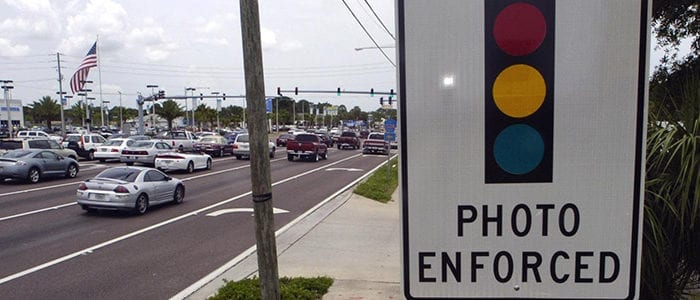Editorial: End red-light camera ticket program
In 2010, Suffolk County hired a contractor to install cameras at certain dangerous, traffic-light intersections with the expressed purpose of improving public safety, since running red lights is a major cause of crashes, injuries and death. Currently, 100 camera locations are used for traffic light enforcement in Suffolk County.
To say those cameras have been controversial is an incredible understatement. In theory, if people were automatically issued traffic tickets when cameras detect violations, then people would be less likely to run a red light. However, the effectiveness of the program is hotly debated, both nationally, as well as locally. According to the Centers for Disease Control and Prevention, different research methods, when applied, have been used to draw different conclusions. This is the case in Suffolk County, where a recent $250,000 study showed accidents actually increased by about 60 percent at the intersections with cameras, while the number of crashes with injuries decreased, and the total number of fatalities remained the same.
Despite conclusive findings, the study’s author, L.K. McLean Associates of Brookhaven, has recommended that legislators continue the program, because the combined statistics of fatalities and injuries decreased overall. The Republican caucus disagrees. They call the program “a money grab.”
The issue, though, is not totally partisan. Legislator Sarah Anker (D-Mount Sinai) said she was extremely underwhelmed with the report, saying it gave no indication that the cameras prevented crashes.
The county explicitly states on its website that making money is not the main purpose of the camera program: “The goal of photo enforcement is to deter violators, not catch them.”
But the program in nine years has generated about $190 million.
Under the current system, violators pay a $50 fine, when a camera catches them running a red light, plus a $30 administration fee, plus $25, if violations are paid late. According to contract terms, the county’s vendor Conduent gets 42 percent of citation revenue. In 2018, for example, the county is estimated to receive $27.5 million from the program with $8.8 million being fees for services, most of which are going to Conduent. The balance of the revenue is transferred into a police district account and is used to finance its operations.
The red-light issue should not be political — it should be about public safety. Without clear safety data to justify its existence, we at TBR News Media believe the program should be discontinued at the end of 2019.
If there is a financial benefit to the program for the police district, these interests should be made more apparent, so the public good is understood. If revenue is in fact driving support for this program, then the county needs to compare multiple vendor offers. A 42 percent share of revenue paid to an outside vendor seems incredibly high. So is the program’s administration fee, which is estimated at $9.5 million for 2018. It’s unclear what this fee is for exactly. The county needs more transparency on this topic.
The outcome of the Sept. 4 county vote was not available by press time.







